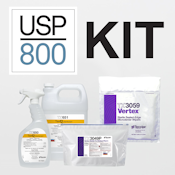|
The Effectiveness of the TexQ Decontamination Protocol |
|
| Q u i c k N a v i g a t i o n |  Buy Now! Protocol Included |
| Summary | |
| Introduction - USP 800 | |
| What is a Hazardous Drug? | |
| Testing | |
| - Purpose | |
| - Experimental | |
| - Results | |
| - Conclusion | |
Summary
The Texwipe-developed decontamination protocol that includes TexQ cleaner and disinfectant and 70% USP-grade Isopropyl Alcohol (IPA) pre-wetted wipers was shown to remove at least 99.99% of several hazardous drugs commonly processed in compounding pharmacies. The testing was performed by Bureau Veritas North America (BVNA)
Introduction - USP 800
The American Society of Health-System Pharmacists (ASHP), National Institute for Occupational Safety and Health (NIOSH), part of Centers for Disease Control and Prevention (CDC), Occupational Safety & Health Administration (OSHA), and The United States Pharmacopeial Convention (USP) have documented the health risks associated with handling hazardous drugs for workers associated with the healthcare industry, including compounding pharmacists, nurses and doctors, and others such as janitorial personnel, researchers, even shipping and receiving personnel. The upcoming USP includes other personnel who may potentially be exposed to HDs (Hazardous Drugs): pharmacists, pharmacy technicians, physician assistants, home healthcare workers, veterinarians, and veterinary technicians. These health risks may range from a skin rash to reproductive issues (infertility, birth defects), organ damage and possible cancerous outcomes. Because of the severe impact to a wide range of personnel, the ASHP Guidelines, OSHA’s Technical Manual, and current USP chapter prescribe safe handling practices for these drugs. At the time of this writing, USP has a pending chapter, USP , titled, “Hazardous Drugs - Handling in Healthcare Settings,” which will apply to the above healthcare workers, who receive, store, compound, dispense, administer, and dispose the hazardous drugs. According to that chapter, handling hazardous drugs safely using proper engineering controls and correct handling practices including good decontamination protocols plays a crucial role in maintaining a controlled environment and ensuring personnel protection in the workplace. An effective process of hazardous drugs decontamination requires their safe removal from fixed work and adjacent surfaces to the appropriate disposal outside the compounding area. Texwipe developed a protocol which includes TexQ, a disinfectant and cleaner, and wipers pre-wetted with a 70% USP-grade IPA solution for the decontamination of surfaces exposed to hazardous drugs. The efficacy of that protocol was assessed at Bureau Veritas North America (BVNA), an independent testing organization internationally recognized as a leader in testing, inspection, and certification.
What is a Hazardous Drug?
Drugs considered hazardous include those that exhibit one or more of the following six characteristics in humans or animals:
• Carcinogenicity
• Teratogenicity or other developmental toxicity †
• Reproductive toxicity †
• Organ toxicity at low doses †
• Genotoxicity
• Structure and toxicity profiles of new drugs that mimic existing drugs determined hazardous by the above criteria
† All drugs have toxic side effects, but some exhibit toxicity at low doses. The level of toxicity reflects a continuum from relatively nontoxic to production of toxic effects in patients at low doses (for example, a few milligrams or less).
Purpose
BVNA proposed activities to assess the efficacy of the Texwipe decontamination protocol that uses sterile TexQ cleaner and disinfectant and sterile 70% IPA pre-wetted wipers for the removal of hazardous drug residues from a standard test surface. All tests were performed using 316-grade stainless steel as the substrate test surface. Spiking of substrate surfaces was performed in a consistent manner throughout the study using hazardous drug solutions in solvent, according to the relevant BVNA Standard Operating Procedures (SOPs). Texwipe’s protocol was adapted by BVNA to be performed in a standardized and consistent manner. The post cleaning sample collection, extraction and analysis are as defined and validated in the relevant BVNA testing methods. The protocol efficacy was evaluated in two phases to ensure its proper validation. Phase I was limited to evaluation of the protocol’s decontamination efficacy for 5-fluorouracil (5-FU). A successful result of 99.99-100.00% efficacy (mean effectiveness) was obtained in Phase I. With these results, the study was broadened to include other hazardous drugs, and the study was moved into Phase II. Phase II, testing with multiple drug products, was implemented to show that the decontamination protocol was effective for multiple hazardous drug products. The test results for this phase showed an efficacy of 99.99-100.00% for all tested compounds.
Experimental
A 316-grade stainless steel coupon was spiked with one hundred micrograms of a specific hazardous drug in solution. This process was performed according to relevant BVNA Standard Operating Procedures (SOPs). The dried, spiked coupons were decontaminated according to Texwipe’s protocol. The cleaned surfaces were sampled by swabbing the coupon surface. The swabs were extracted, and the extract was analyzed using a LC/MS/MS separation, detection, quantification technique for the level of the remaining spiked hazardous drug on the coupon as defined and validated in the relevant BVNA testing method SOPs. The decontamination protocol consisted of wetting a dry wiper with TexQ TX650 cleaner and disinfectant, wiping the contaminated surface using parallel, overlapping strokes, wiping again with a 70% IPA pre-wetted wiper using parallel, overlapping strokes, and repeating these steps again at ninety degrees to the first steps. The results of the protocol efficacy testing are shown below.
Results
The decontamination protocol efficacy was first evaluated using one hazardous drug, 5-fluorouracil. The results of this evaluation were compiled in Table 1. The results for 5-fluorouracil indicated that the protocol was 99.99% effective for decontaminating surfaces soiled with the hazardous drug, 5-fluorouracil. The test was repeated for a total of three samples.
| Table 1. Phase l results using 5-fluorouracil as the test substance | |||||
| Drug | Sample # | Dosed, mcg | Recovered*, mcg | Cleaned, % | Mean Effectiveness |
| 5-fluorouracil | 1 | 100 | 0.006 | 99.994 | 99.990% |
| 2 | 100 | 0.010 | 99.990 | ||
| 3 | 100 | 0.013 | 99.987 | ||
| mcg - micrograms *The limit of quantitation (LOQ) is 0.001 mcg per sample for 5-fluorouracil |
With the protocol shown to be effective for 5-fluorouracil, Phase I was completed. The protocol was next validated against other hazardous drugs for the Phase II evaluation. These results are compiled in Table 2.
| Table 2. Phase ll results using five hazardous drug substances |
|||||
| Drug | Sample # | Dosed, mcg | Recovered*, mcg | Cleaned, % | Mean Effectiveness |
| 5-fluorouracil | 1 | 100 | 0.001 | 99.999 | 99.994% |
| 2 | 100 | 0.007 | 99.993 | ||
| 3 | 100 | 0.009 | 99.981 | ||
| Cyclophosphamide | 1 | 100 | 0.001 | 99.999 | 99.999% |
| 2 | 100 | 0.001 | 99.999 | ||
| 3 | 100 | 0.002 | 99.998 | ||
| Ifosfamide | 1 | 100 | 0.001 | 99.999 | 99.998% |
| 2 | 100 | 0.001 | 99.999 | ||
| 3 | 100 | 0.002 | 99.998 | ||
| Paclitaxel | 1 | 100 | 0.002 | 99.998 | 99.996% |
| 2 | 100 | 0.009 | 99.991 | ||
| 3 | 100 | 0.002 | 99.998 | ||
| Methotrexate | 1 | 100 | 0.002 | 99.998 | 99.997% |
| 2 | 100 | 0.003 | 99.997 | ||
| 3 | 100 | 0.005 | 99.995 | ||
| mcg - micrograms *The limit of quantitation (LOQ) is 0.001 mcg per sample for 5-fluorouracil, Cyclophosphamide, Ifosfamide, and Methotrexate. The LOQ is 0.002 mcg per sample for Paclitax |
These results complete Phase II, showing at least 99.99% effectiveness for decontaminating surfaces soiled with several hazardous drugs: 5-fluorouracil, Cyclophosphamide, Ifosfamide, Paclitaxel and Methotrexate.
Conclusion
The decontamination protocol containing TexQ cleaner and disinfectant and 70% IPA (Isopropyl Alcohol) pre-wetted wipers was shown to remove at least 99.99% of numerous hazardous drugs compounds commonly used in sterile compounding pharmacies: 5-fluorouracil, Cyclophosphamide, Ifosfamide, Paclitaxel and Methotrexate. The proper combination of products, wiping technique and the protocol steps proposed by Texwipe are important to obtain effective surface cleaning results in the decontamination process.
Purchase the USP 800 Kit Below:
